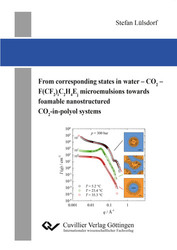| Fachbereiche | |
|---|---|
| Buchreihen (96) |
1378
|
| Nachhaltigkeit |
3
|
| Gesundheitswesen |
1
|
| Geisteswissenschaften |
2365
|
| Naturwissenschaften |
5406
|
| Mathematik | 229 |
| Informatik | 319 |
| Physik | 980 |
| Chemie | 1363 |
| Geowissenschaften | 131 |
| Humanmedizin | 243 |
| Zahn-, Mund- und Kieferheilkunde | 10 |
| Veterinärmedizin | 108 |
| Pharmazie | 147 |
| Biologie | 835 |
| Biochemie, Molekularbiologie, Gentechnologie | 121 |
| Biophysik | 25 |
| Ernährungs- und Haushaltswissenschaften | 45 |
| Land- und Agrarwissenschaften | 1004 |
| Forstwissenschaften | 201 |
| Gartenbauwissenschaft | 20 |
| Umweltforschung, Ökologie und Landespflege | 148 |
| Ingenieurwissenschaften |
1793
|
| Allgemein |
98
|
|
Leitlinien Unfallchirurgie
5. Auflage bestellen |
|
Erweiterte Suche
From corresponding states in water – CO2 – F(CF2)iC2H4Ej microemulsions towards foamable nanostructured CO2-in-polyol systems
Stefan Lülsdorf (Autor)Vorschau
Inhaltsverzeichnis, PDF (180 KB)
Leseprobe, PDF (1 MB)
Today there is an increased focus on a considerable reduction of the total energy consumption in the world. As the heating of buildings constitutes a large part of this consumption, the development of highly efficient thermal insulation materials is highly demanded. The most promising class are polymeric nanofoams, which might be producible by using the “Principle Of Supercritical Microemulsion Expansion” (POSME). Within this approach, microemulsions with a high number density of CO2 nano-pools in a polymerizable material (e.g. polyol) are used as templates. Adjusting supercritical conditions, the nucleation of gaseous CO2 during the expansion is avoided, so that each CO2-swollen micelle should ideally grow to a nanopore. However, due to aging phenomena, so far only polyurethane (PU) foams with microcellular pores could be produced applying this approach. In order to improve the properties of the foamable microemulsion template, microemulsions of the type water – CO2 – non-ionic fluorinated surfactant (Capstone® FS-3100) were studied in the first part of this thesis as a model system. Small angle neutron scattering (SANS) measurements for the first time revealed the phase inversion from CO2-swollen micelles in water via bicontinuous structures to water-swollen micelles in CO2. Using a scaling description developed for microemulsions of the type water –alkane – CiEj, the temperature dependence of the length scales found in classical and CO2-microemulsions fall on top of each other. Moreover, the partial replacement of CO2 by cyclohexane was found to increase the efficiency of the fluorinated surfactant to form a bicontinuous microemulsion. This efficiency boosting could be correlated with the increase of the bending rigidities κ0,SANS and κNSE determined by SANS and neutron spin echo (NSE). In the second part of this thesis the gained knowledge was successfully used to formulate CO2-in-polyol microemulsions appropriate for the production of nanocellular PU foams. Using SANS and partly deuterated polyol, not only the formation of micelles in the binary mixture of polyol and non-ionic siloxane surfactant, but also their swelling with CO2 could be proven. The change of the microstructure upon fast expansion and compression was studied combining time-resolved SANS-measurements and periodic pressure jumps. Interestingly, the pressure induced structural changes follow the pressure profile instantaneously, i.e. faster than the time resolution of 50 ms.
| ISBN-13 (Printausgabe) | 9783736970311 |
| ISBN-13 (E-Book) | 9783736960312 |
| Buchendformat | A5 |
| Sprache | Englisch |
| Seitenanzahl | 226 |
| Umschlagkaschierung | matt |
| Auflage | 1. |
| Erscheinungsort | Göttingen |
| Promotionsort | Stuttgart |
| Erscheinungsdatum | 21.06.2019 |
| Allgemeine Einordnung | Dissertation |
| Fachbereiche |
Physikalische Chemie
|
| Schlagwörter | Microemulsion, Mikroemulsion, CO2, Kohlenstoffdioxid, carbon dioxide, nanostructured, nanostrukturiert, phase behavior, Phasenverhalten, corresponding state description, korrespondierende Zustandsbeschreibung, phase inversion, Phaseninversion, nanofoam, Nanoschaum, POSME, supercritical, überkritisch, micelle, Mizelle, F(CF2)iC2H4Ej, Polyol, PU, polyurethane, Polyurethan, surfactant, Tensid, fluorinated, fluoriert, Capstone® FS-3100, Zonyl®, SANS, siloxane surfactant, small angle neutron scattering, Kleinwinkelneutronenstreuung, NSE, neutron spin echo, bending rigidity, Biegesteifigkeit, time-resolved, zeitaufgelöst, pressure jump, Drucksprünge, co-oil, efficiency boosting, bicontinuous, bikontinuierlich, lamellar, characteristic length scale, charakteristische Längenskala, cmc, critical micelle concentration, kritische Mizellbildungskonzentration, Teubner-Strey, Zilman-Granek, Guinier |








